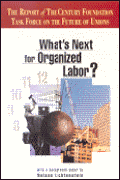For thirty years, labor unions have been in a slump. Private sector membership has eroded steadily and dramatically. Hostility toward unions among politicians and the general public has increased. Economic globalization, new technology, and changes in the workplace have compounded the resistance of employers to unions. Unions face substantial legal obstacles when attempting to organize and then gain an initial contract with employers. And, in some unions, scandals continue to obscure reform efforts.
Recently, the Twentieth Century Fund/Century Foundation convened a task force of business executives, labor leaders, academics, and others who care about the well-being of the American workforce to reconsider the future of unions. Under the chairmanship of former Ohio Governor Richard Celeste, the task force explored provocative questions: Are labor unions outmoded anachronisms? Or do they have the capacity to revitalize themselves and regain an important role in the U.S. economy and political system?
This book argues that labor unions have proven to be the only consistently effective mechanism for enabling workers to express their concerns and exert significant influence in the workplace. It also documents the extent to which unions have benefited not only members, but the workforce as a whole. The report also includes a variety of new ideas for regaining membership, rebuilding public popularity, developing greater flexibility in the workplace, and shaping government policy.
The book includes a background paper analyzing the labor movement’s ups and downs by Nelson Lichtenstein, professor of political science at the University of Virginia.

